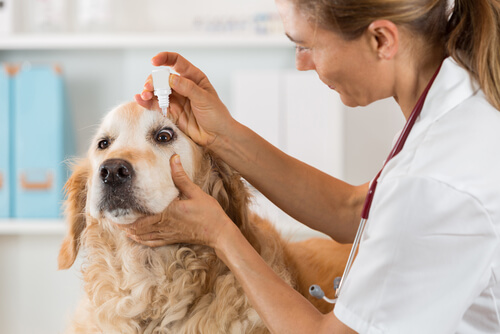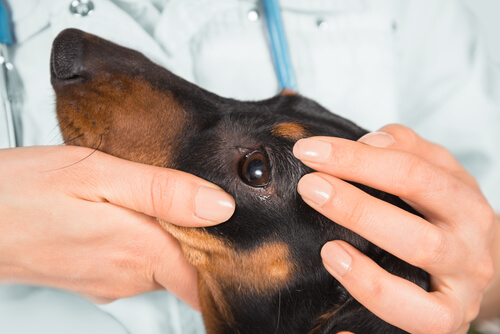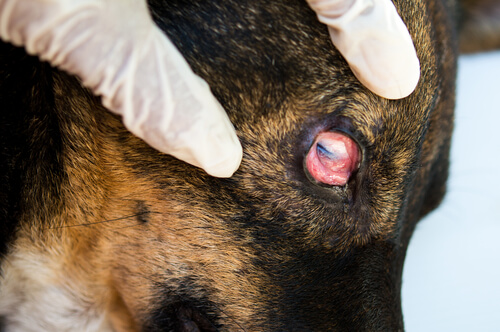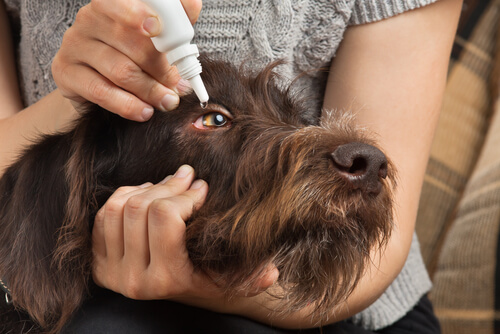Natural Treatment for Conjunctivitis in Dogs

Sight is one of the most important senses when interacting with the world, not only for humans, but also for animals. Eyes are exposed to various factors that can cause different illnesses to affect them. So, it’s necessary to get to know some of the symptoms of the disease, as well as some natural treatment for conjunctivitis in dogs.
What is conjunctivitis?
The first thing we need to explain is that the term conjunctivitis refers to the swelling of the conjunctiva of the eye. It’s defined as the inflammation of the moist, pinkish membrane that covers the lower part of the eyelids, as well as the anterior ‘white’ part of the eye, which can lead in the long term to a total loss of sight.
What are the causes of conjunctivitis in dogs?
Before determining which natural treatment for conjunctivitis in dogs can help your pet, you need to know the causes that produce the disease. While only the veterinarian can establish why the infection occurs, having a general knowledge of such reasons will help alleviate the discomfort.

Generally speaking, there are two possible causes. Firstly, there are eye problems, mostly caused by viruses, fungi, and bacterial infections. Irritants, allergies, ulcers due to foreign bodies in the eye, and eyelid malformations also contribute to this type of conjunctivitis.
On the other hand, symptomatic diseases such as hepatitis, canine distemper, and keratoconjunctivitis sicca (dry eye) have conjunctivitis as a symptom in dogs, a consequence of an irritated conjunctival membrane.
We must take into account that certain breeds of dogs, for hereditary reasons, are more prone to suffer from this pathology, so it becomes essential for owners to get to know natural treatments for conjunctivitis in dogs such as the poodle, the cocker spaniel, the pug, and the Pekingese.
How to know if my dog has conjunctivitis?
The symptoms are varied and depend on the causes of the disease, but it’s good to mention the most frequent ones in order to be able to recognize it. If you pay enough attention to your pet’s eye health, it’s possible to determine whether or not they’re suffering from conjunctivitis.

To know whether you should use a natural treatment for conjunctivitis in dogs, you need to check what the symptoms are. One of the most evident is the redness and swelling of the eye, which makes it difficult for the dog to open it, and them not wanting contact with natural or artificial light.
The dog will tend to scratch the affected area excessively, which creates a greater risk to the health of the eye. The whitish, colorless secretions, and, in the most severe cases, green or yellow purulent ones, don’t take long to appear and often prevent the separation of the eyelids.
What to do when I suspect conjunctivitis?
When you suspect that your dog may have conjunctivitis, the first step is to consult a veterinarian. The specialist is the only one who can diagnose the condition, and, depending on whether the infection is caused by a virus, a fungus or an allergen, they’ll prescribe the appropriate medication.
If you can’t take your dog to the vet immediately, the ideal thing is to start with eye cleaning. With a physiological saline solution, three or four times a day, try to remove all types of secretions and leave the eye clean. Under no circumstances apply eye drops that are for human use, as this will only worsen the situation.

Dogs, in their desperation, may scratch tirelessly, in an attempt to alleviate the annoying consequences of the infection. To protect the eyes, you’ll need to place an Elizabethan or bell collar to optimize the animal’s recovery time.
Natural treatments for conjunctivitis in dogs
When it comes to natural medicine, many methods can be used to treat the condition, both in humans and animals. In the case of conjunctivitis in dogs, we’re going to highlight some of the best ways to treat it. By following our guide, you’ll be able to apply the natural treatment for conjunctivitis in dogs that best suits the patient.
- Chamomile infusion: This is one of the easiest and most widely used treatments for conjunctivitis, as it has anti-inflammatory, antibacterial, and sedative properties. You only need to make an infusion of chamomile (even with instant sachets) and let it cool. After that, moisten a gauze with it and clean their eye. Some other alternative plants that you can use for the same purpose are oregano, fennel, calendula, and thyme.
- Black tea and horsetail infusions: Both infusions help to clean the eye and you can use them up to three times a day, while the veterinarian prepares the treatment to reduce the swelling of the eye.
- Hot and cold compresses: To alleviate the symptoms of conjunctivitis in dogs, it’s essential to alternate between warm and cold compresses. Heat helps to reduce irritation and cold helps reduce inflammation and redness. Five minutes of each are necessary for the treatment to take effect.
- Eyes away from the light: As far as possible, keep your dog’s eyes away from bright lights, both natural and artificial, because they contribute to the irritation and dryness of the eye, which accelerates the process of conjunctivitis.
- Quality food: The body’s defenses depend on a good diet. That’s why you should ensure your furry friend ingests the necessary amount of nutrients to keep their health stable, thus helping them to quickly fight infections.
Be very careful to wash and use sterile gauze to apply the infusions. Don’t use the same cloth on both eyes either, as this will only aggravate the problem. If symptoms worsen, discontinue the application of any natural remedy and consult a veterinarian immediately.
Keep in mind that natural remedies help to control the most obvious symptoms, but, in certain situations, they may not work completely. Therefore, they should always be accompanied by the corresponding veterinary treatment, otherwise it might take a while to cure your pet. Take your pet for a check-up as soon as you can and don’t let it suffer with the discomfort for too long.